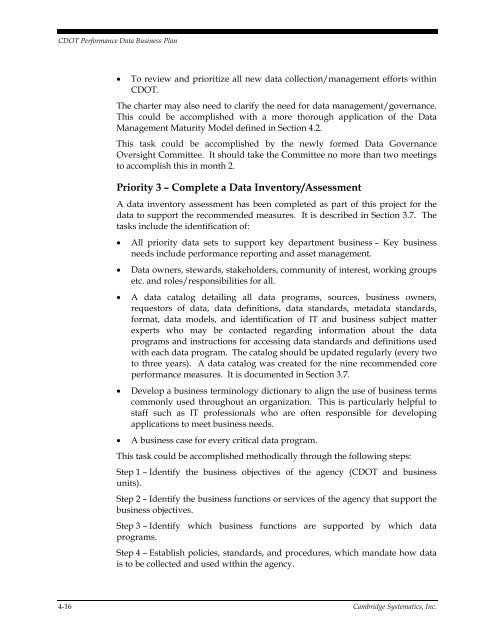CDOT Performance Data Business Plan - Cambridge Systematics
CDOT Performance Data Business Plan - Cambridge Systematics
CDOT Performance Data Business Plan - Cambridge Systematics
Create successful ePaper yourself
Turn your PDF publications into a flip-book with our unique Google optimized e-Paper software.
<strong>CDOT</strong> <strong>Performance</strong> <strong>Data</strong> <strong>Business</strong> <strong>Plan</strong><br />
<br />
To review and prioritize all new data collection/management efforts within<br />
<strong>CDOT</strong>.<br />
The charter may also need to clarify the need for data management/governance.<br />
This could be accomplished with a more thorough application of the <strong>Data</strong><br />
Management Maturity Model defined in Section 4.2.<br />
This task could be accomplished by the newly formed <strong>Data</strong> Governance<br />
Oversight Committee. It should take the Committee no more than two meetings<br />
to accomplish this in month 2.<br />
Priority 3 – Complete a <strong>Data</strong> Inventory/Assessment<br />
A data inventory assessment has been completed as part of this project for the<br />
data to support the recommended measures. It is described in Section 3.7. The<br />
tasks include the identification of:<br />
<br />
<br />
<br />
<br />
<br />
All priority data sets to support key department business – Key business<br />
needs include performance reporting and asset management.<br />
<strong>Data</strong> owners, stewards, stakeholders, community of interest, working groups<br />
etc. and roles/responsibilities for all.<br />
A data catalog detailing all data programs, sources, business owners,<br />
requestors of data, data definitions, data standards, metadata standards,<br />
format, data models, and identification of IT and business subject matter<br />
experts who may be contacted regarding information about the data<br />
programs and instructions for accessing data standards and definitions used<br />
with each data program. The catalog should be updated regularly (every two<br />
to three years). A data catalog was created for the nine recommended core<br />
performance measures. It is documented in Section 3.7.<br />
Develop a business terminology dictionary to align the use of business terms<br />
commonly used throughout an organization. This is particularly helpful to<br />
staff such as IT professionals who are often responsible for developing<br />
applications to meet business needs.<br />
A business case for every critical data program.<br />
This task could be accomplished methodically through the following steps:<br />
Step 1 – Identify the business objectives of the agency (<strong>CDOT</strong> and business<br />
units).<br />
Step 2 – Identify the business functions or services of the agency that support the<br />
business objectives.<br />
Step 3 – Identify which business functions are supported by which data<br />
programs.<br />
Step 4 – Establish policies, standards, and procedures, which mandate how data<br />
is to be collected and used within the agency.<br />
4-16 <strong>Cambridge</strong> <strong>Systematics</strong>, Inc.

















